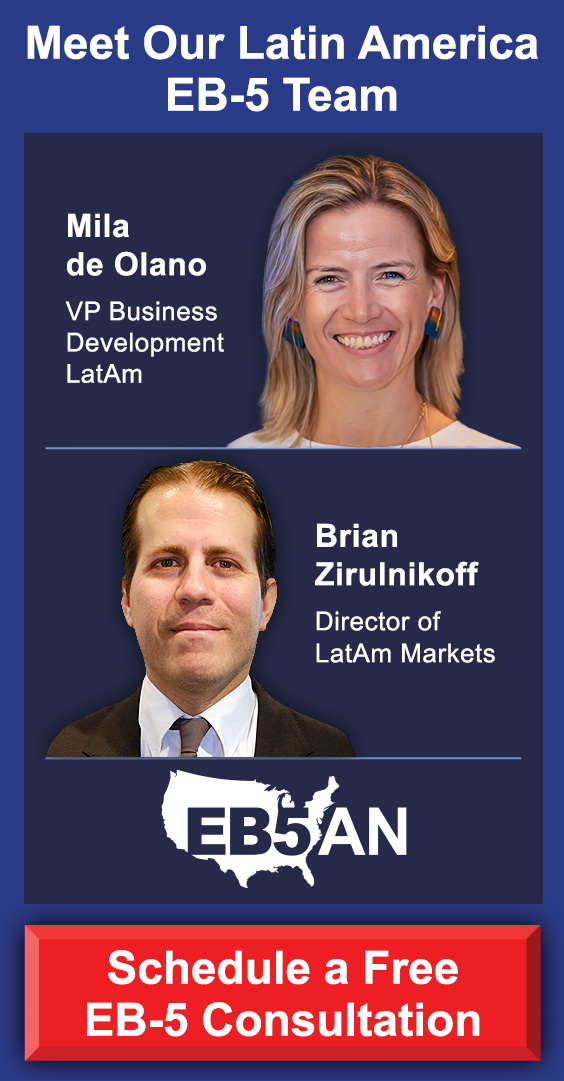The world is changing fast. Artificial Intelligence (AI) has become ubiquitous, and the number of AI-related tools continues to grow.
It’s no surprise that its use is becoming more common under the EB-5 Immigrant Investor Program application process. More investors are using it to make due diligence faster, more accurate, and easier to understand.
In this article, we’ll explain what you need to know about how to use AI in EB-5 program due diligence. We’ll also tell you why partnering with EB5AN’s expert team is a smart move for any prospective EB-5 investor.
How AI Is Impacting the EB-5 Process
How to Use AI at Each Stage of the Due Diligence Process
- 1. Project Documentation
- 2. Job Creation
- 3. Regional Center and Project Developer Track Record
- 4. Fund Flow and Capital Protection
- 5. Financial Health and Project Viability
- 6. Legal and Immigration Risks
- 7. Investor Reporting and Transparency
5 General Tips for Using AI Effectively in Due Diligence
- 1. Use AI for Speed, Not a Substitute for Legal Advice
- 2. Focus on Cross-Checking, Not Just Automation
- 3. Keep Your Own AI “Dashboard”
- 4. Watch Out for AI Overconfidence
- 5. Use AI to Make Reporting Clearer
Bringing AI Into Your EB-5 Journey
How AI Is Impacting the EB-5 Process
AI technologies are having a huge impact on the EB-5 process across the board.
They offer great general benefits. AI technologies can quickly create content, analyze huge datasets, and summarize long, complex documents.
They’re especially useful when it comes to due diligence, because the huge number of EB-5 documents and data to be assessed can be overwhelming. Investors may find it time-consuming or difficult to make sound conclusions. AI can help speed up research, improve risk scoring, integrate immigration/regulatory review, and provide due diligence report support.
AI strengthens the investor’s position in identifying project risks, comparing opportunities, and documenting their analysis. It mitigates the financial risk and immigration risk connected to the EB-5 program.
How to Use AI at Each Stage of the Due Diligence Process
A successful EB-5 program application depends on proper due diligence at every stage.
When working through the documentation for an EB-5 project, integrating AI tools can significantly enhance your due diligence, accuracy, and efficiency.
Let’s take a closer look at where AI can best fit into each of these stages. Below we’ve prepared a breakdown of how AI can help, what you should ask the AI to scrutinize, which platforms/tools you might use, and what using them involves for each stage of EB-5 due diligence.
Note that while some of the platforms mentioned below can be used directly by immigrant investors, others are paid-for services or require expert support. They may not be available to every investor, and using all of them could prove time-consuming.
1. Project Documentation
These are essential EB-5 project documents to remember when considering whether to use AI tools at this stage.
- Private placement memorandum (PPM)
- Subscription agreement
- Limited partnership/operating agreement
- Business plan (Matter of Ho compliance)
- Economic report
- Offering memorandum updates
AI can help with collecting and processing these project documents in the following ways:
- AI document analysis: Use natural language processing (NLP) to scan PPMs, subscription agreements, and business plans for inconsistencies, missing risk disclosures, or clauses unfavorable to investors. AI can scan large volumes of investment documents and flag missing items, inconsistencies, or ambiguous language.
- Suggested platform: Robin AI – scans PPMs, contracts, and operating agreements for risky clauses.
- Directly usable by investors (SaaS subscription).
- Clause comparison tools: AI can benchmark language against past documents approved by United States Citizenship and Immigration Services (USCIS) to flag unusual or risky provisions.
- Suggested platform: Tools: Lexis+ Agreement Analysis – benchmarks contract language against large precedent databases.
- Requires expert support (law firm or licensed legal researcher).
- Summarization: Quickly generate executive summaries so investors or attorneys don’t need to manually review every page.
- Suggested platform: Harvey AI (used by law firms) – generates concise executive summaries of complex legal docs.
- Service-based (only available through law firms using Harvey).
2. Job Creation
The EB-5 program requires job creation of at least 10 full-time U.S. jobs per investor. AI can add value by modeling job creation, monitoring performance, flagging deviations, and supporting audit readiness and regulatory compliance.
Remember these important elements of the EB-5 program’s job creation requirements when thinking about whether to use AI technologies.
- Job creation forecast
- Direct, indirect, and induced jobs
- Economic methodology
- Timing of job creation
Let’s break down in greater detail how AI can help in fulfilling EB-5 job-creation requirements, including where AI can help, what it should scrutinize, which platforms or tools might be used, and what using them practically entails.
- Economic model validation: AI can run scenario analyses on job creation forecasts using commonly accepted EB-5 economic methodologies (RIMS II, IMPLAN), spotting optimistic assumptions or stress-testing alternative cases.
- Suggested platform: Tableau + RIMS II/IMPLAN datasets with AI plugins – allows scenario analysis of EB-5 job creation forecasts.
- Requires expert support (economist or data analyst to run models).
- Automated data feeds: AI can continuously update job creation models with real-time construction spending and operations data, producing more accurate job counts.
- Suggested platform: Alteryx Auto Insights – ingests real-time construction/operations data and updates econometric models automatically.
- Requires expert support (data integration + technical setup).
- Visualization: AI tools can translate complex econometric data into simple dashboards for investors.
- Suggested platform: Power BI with AI Copilot – builds simple dashboards to help non-experts understand complex job creation models.
- Directly usable by investors (user-friendly, though setup guidance helps).
- Forecasting and modeling job creation: AI can analyze the business plan, economic impact studies, and job‐creation models (direct, indirect, induced) to forecast the number of jobs expected, estimate risk of shortfall, and test various scenarios.
- Monitoring actual job creation and sustainment: After the investment is made and the enterprise is operational, AI can assist in tracking whether the jobs are actually being created as projected (e.g., by analyzing payroll, W-2s, tax records, employment data), and that the investment is sustained for the required period (a minimum of two years).
- Detecting discrepancies or anomalies: AI can flag inconsistencies between projected vs. actual job figures, missing jobs, under-utilization of workforce, misclassification (part-time vs full-time), or job sharing issues (since EB-5 requires that each job created be full-time, with at least 35 hours/week worked).
- Risk scoring and early‐warning: By benchmarking across historical EB-5 investment projects, AI can identify higher‐risk projects that may struggle to meet job creation, giving investors or sponsors early warning.
- Suggested platform: Xapien: AI powered due diligence / third-party risk analysis platform that could be used to monitor project sponsors, developers, job-creating entities for reputation, performance risk.
- Ongoing compliance monitoring: AI can help continuously monitor regulatory updates, project performance, regional center audits, job creation methodology and reports, and flag when there may be non-compliance or a risk that job creation might fail to meet requirements.
- Suggested platforms: Solix ECS: AI-powered compliance monitoring, document classification for financial/regulated entities; Compliance.ai and similar RegTech platforms for scanning regulatory updates and mapping to internal obligations.
- Document management and audit readiness: AI tools can organize, extract, index and summarize relevant documentation (payroll records, employment eligibility verification, economic impact reports) so that when the investor files the petition (e.g., Form I-829) they have ready documentation demonstrating job creation.
3. Regional Center and Project Developer Track Record
Nearly all EB-5 investors make their investments via regional centers. Choosing a particular regional center and project developer are critical decisions for any EB-5 applicant.
AI tools can rapidly analyze vast amounts of public data on regional centers and developers: track records, litigation history, prior project outcomes, and USCIS filings. They can compare multiple regional centers/developers side-by-side on metrics (such as past I-526E/I-829 approvals, fund repayments, and project delays). They can also flag inconsistencies or red flags in project documents.
These are important issues related to regional centers and developers to remember when thinking about whether to use AI technologies.
- Regional center’s track record of approval
- Past performance
- Project completions
- Management team
Let’s take a closer look at how AI can help with choosing an EB-5 program regional center and developer, including where AI can help, what it should scrutinize, which platforms or tools might be used, and what using them practically entails.
- Background screening: AI-powered tools can scan litigation databases, news, sanctions lists, and corporate registries for negative history tied to principals. They can scrutinize regional center credentials for genuine USCIS regional center designation, audit history, and annual filings.
- Suggested platform: Palantir Foundry / Refinitiv World-Check – scans litigation, sanctions, and corporate databases for negative history.
- Service-based (licensed by compliance firms and banks).
- Predictive risk scores: Machine learning models can assess the likelihood of developer default based on past projects, market conditions, and financing structures. They can search for conflicts of interest and governance.
- Suggested platform: Moody’s Analytics CreditEdge – machine-learning-based scoring of developer/project default risk.
- Requires expert support (institutional-level subscription).
- Approval history mapping: AI can analyze publicly available adjudication trends and reported outcomes; where available, compile regional-center-level history from public disclosures and reputable industry reports.
4. Fund Flow and Capital Protection
Making a qualifying investment is critical to the success of an EB-5 application.
AI tools can monitor and analyze the flow of EB-5 investor capital — from escrow to the project’s bank accounts, into the job-creating enterprise, and ultimately to exit/repayment. For example, AI can flag if an investor’s funds are diverted, not disbursed according to the terms, or if abnormal cash-flows appear. Real-time dashboards can provide transparency into fund movements and audit trails.
These are important issues related to fund flow and capital protection to remember when thinking about whether to use AI technologies.
- Escrow arrangements
- Capital deployment
- Third-party oversight
- Debt vs. equity structure
- Exit strategy
Let’s examine how AI can help with making the right choices when it comes to fund flow and capital protection, including where AI can help, what it should scrutinize, which platforms or tools might be used, and what using them practically entails.
- Transaction monitoring: AI algorithms can trace EB-5 funds through escrow and disbursement, flagging anomalies.
- Suggested platform: ComplyAdvantage – AML/KYC AI that tracks unusual financial flows in escrow accounts.
- Service-based (used by fund administrators, not investors directly).
- Smart contracts: In some cases, AI can assist in validating escrow release triggers tied to USCIS approvals or construction milestones.
- Risk simulation: Run financial stress tests to evaluate repayment capacity under different market conditions.
- Suggested platform: MATLAB with AI add-ons / Riskturn – runs stress tests and Monte Carlo simulations on repayment capacity.
- Requires expert support (quantitative analyst/finance professional).
- Third party oversight: Use AI to evaluate third-party fund administrators. A third-party fund administrator plays a critical role in EB-5 due diligence by providing independent oversight of the project’s finances, ensuring compliance with immigration regulations, and offering transparency to investors.
Here are some specific ways to leverage AI in following the flow of EB-5 investor capital:
- Collect and upload the key documents: escrow agreement, fund administration agreement, subscription agreement, capital-stack breakdown, audit reports.
- Use an AI tool to extract cash-flow chains: from investor → escrow → new commercial enterprise (NCE) → JCE → job creation investment. Check whether each step aligns with the approved offering.
- Set up alerts or dashboards: e.g., if funds leave escrow without supporting documentation, if repayments are delayed, or if fund-admin roles change.
- Review AI-flagged issues with human specialists (immigration attorneys, fund-admins, auditors): e.g., verify that fund-admin is independent and that auditors issued an unqualified opinion.
- Maintain an audit-trail. Keep records of the AI prompts & outputs, fund-flow logs, audits, so that you have documentation if there is an USCIS review or investor exit.
5. Financial Health and Project Viability
A financially healthy EB-5 project is more likely to be a viable project.
AI can ingest and analyze offering documents, capital-stack spreadsheets, feasibility studies and third-party reports, and flag issues such as unusually high EB-5 project financing, weak developer equity, overly leveraged projects, vague use-of-funds schedules, or feasibility studies with unrealistic assumptions.
Remember these important issues related to financial health and project viability when thinking about whether to use AI technologies.
- Sources and uses of funds
- Loan-to-value ratios
- Developer equity contribution
- Third-party financing
- Feasibility studies
Let’s take a closer look at how AI can help with EB-5 project evaluation and assessments of financial health, including where AI can help, what it should scrutinize, which platforms or tools might be used, and what using them practically entails.
- Automated financial ratio analysis: AI tools can scan balance sheets, loan documents, and pro formas, highlighting unsustainable debt ratios or weak equity positions.
- Suggested platform: Kira Systems – extracts and analyzes key ratios from balance sheets, loan docs, and pro formas.
- Service-based (used by law/accounting firms).
- Market demand forecasting: AI can analyze real-time data (hotel bookings, apartment rental rates, demographic shifts) to test assumptions in feasibility studies.
- Suggested platform: HouseCanary – AI-driven real estate demand forecasting (rent, hotel occupancy, absorption rates).
- Directly usable by investors (subscription-based).
- Benchmarking: Compare the project against similar developments nationwide to spot inflated projections.
- Suggested platform: Reonomy – compares project data against nationwide developments to identify inflated assumptions.
- Directly usable by investors (subscription-based).
- Feasibility study & financial projections: AI tools can help determine whether assumptions are realistic regarding market demand, the economic impact analysis, job creation, and exit strategy.
Here are some specific ways to leverage AI in evaluating projects and financial health under the EB-5 program.
- Collect all relevant documents: offering memorandum, use-of-funds tables, capital-stack spreadsheets, feasibility study, and third-party reports.
- Upload into AI tool or portal, or prompt the LLM: e.g., “Extract all sources of funding, list amounts and percentages; highlight if EB-5 portion > 30%.”
- Use AI to flag mismatches/concerns: high EB-5 capital percentage, low developer equity, no senior debt, vague uses of funds, and feasibility study assumptions that deviate from norms.
- Manually review AI flags: engage financial analyst/immigration attorney to verify.
- Document the workflow: keep prompt logs, AI outputs, manual review summaries; use this to support decision-making and investor reporting.
6. Legal and Immigration Risks
The EB-5 program poses assorted legal and immigration risks. Fortunately, AI tools can mitigate these by scanning and summarizing large volumes of regulatory decisions, litigation records, immigration-policy guidance, and regional center disclosures to highlight risk areas. AI can also flag inconsistent language in documents, compare policy changes against the project’s terms, and summarize applicable immigration regulatory risks.
Remember these important issues related to legal and immigration risk when thinking about whether to use AI technologies.
- Targeted employment area (TEA) designation
- Redeployment policy
- Litigation history
- Compliance with EB-5 Reform and Integrity Act (RIA) of 2022
Let’s take a closer look at how AI can help evaluate EB-5 legal and immigration risks, including where AI can help, what it should scrutinize, which platforms or tools might be used, and what using them practically entails.
- Policy tracking: AI can monitor changes in USCIS guidance, court rulings, or legislation that could affect project compliance.
- Suggested platform: Manzama / LexisNexis Legal Radar – monitors USCIS guidance, EB-5 rulings, and legislation changes in real time.
- Service-based (used by law firms and compliance professionals).
- TEA verification: AI models can quickly cross-check census tract unemployment or rural designations to confirm TEA eligibility. It can check whether the census tracts cited meet the “high unemployment” or “rural” criteria under RIA, and verify whether state-level designation was replaced by DHS designation.
- Suggested platform: Esri ArcGIS + AI analytics – maps unemployment and rural census tract data for TEA status validation.
- Requires expert support (GIS/data analyst setup).
- Litigation risk prediction: By scanning historic case law, AI can estimate the risk of certain disputes arising (e.g., redeployment or securities compliance issues). It can screen for past or ongoing litigation involving the regional center or developer, terminations of regional centers, or enforcement actions.
- Suggested platform: Premonition Analytics – mines case law to estimate likelihood of litigation outcomes.
- Service-based (licensed to law firms and litigation funders).
Here are some specific ways to leverage AI in assessing EB-5 legal and immigration risk.
- Gather key documents: TEA designation letters, regional center form filings, subscription/operating agreements, prior litigation filings, and audit/annual reports.
- Upload or feed into the AI tool: e.g., “Scan for references to ‘redeployment’ and extract dates, requirements and territories.”
- Use AI to flag anomalies: e.g., “TEA designation date is state-issued post-March 2022 — high risk”, or “redeployment outside RC territory permitted in documents.”
- Conduct human review: immigration attorney or compliance specialist reviews flagged items for regulatory/immigration significance.
- Document the findings: maintain an audit trail of prompts, AI outputs, manual review summary and mitigation plan to support decision-making.
7. Investor Reporting and Transparency
When it comes to investor reporting and transparency, AI can automate the collection, review, and summarization of regular project disclosures. This includes periodic financial statements, job-creation reports, regional center disclosures, and project progress updates. This creates transparency for investors and helps meet the enhanced oversight introduced by the RIA.
AI can also monitor for anomalies or non-compliance signals (delayed reports, missing info, deviation from business plan) and generate alerts for investors or sponsors.
Remember these important issues related to investor reporting and transparency when thinking about whether to use AI technologies.
- Ongoing reporting
- Third-party monitoring
- Communication
Let’s take a closer look at how AI can help evaluate investor reporting and transparency, including where AI can help, what it should scrutinize, which platforms or tools might be used, and what using them practically entails.
- Automated report generation: AI can turn raw construction or financial data into structured investor updates.
- Fraud detection: Machine learning models can spot unusual financial movements in developer reporting.
- Suggested platform: Darktrace for Financials – anomaly detection in developer financial reporting and fund flows.
- Service-based (enterprise cybersecurity/compliance tool).
- Multilingual summarization: AI can automatically translate investor reports into investors’ native languages without losing technical accuracy.
- Suggested platform: DeepL Write + GPT-powered summarizers – produces accurate investor updates in multiple languages.
- Directly usable by investors (off-the-shelf SaaS).
- Frequency and quality of reports and disclosures: AI tool can confirm that annual/quarterly financials are provided, that project progress matches previous disclosures, and that third-party audits are included. They can detect material changes, delays, debt defaults or reported governance changes.
- Background changes: AI can detect new litigation, regulatory actions, adverse findings linked to the regional center or developer.
- Investor communication channels: AI can help ensure that updates are accessible, understandable, and timely, and that audit trails are maintained.
Here are some specific ways to leverage AI in looking at investor reporting and transparency.
- Data gathering: Collect all investor-reporting documents (financial statements, audit reports, job-creation updates, MIAs) and upload them into the AI/platform.
- Prompt/analysis: Use AI to summarize key metrics (“What is the job-creation vs plan this quarter?”), compare to prior periods, flag gaps or late disclosures.
- Alerting & dashboarding: Configure the system to produce alerts when disclosures are late, deviations exceed threshold, or new adverse news arises.
- Review & action: Human compliance/immigration advisor reviews AI-flags, assesses material impact (e.g., immigration risk from delayed job creation) and communicates with investor.
5 General Tips for Using AI Effectively in Due Diligence
Keep these best practices in mind when considering how to use AI effectively as part of your EB-5 program due diligence.
1. Use AI for Speed, Not a Substitute for Legal Advice
- Always validate AI outputs with a professional before making decisions.
2. Focus on Cross-Checking, Not Just Automation
- Use AI tools to compare project forecasts with independent market data (e.g., HouseCanary, Reonomy) rather than relying only on developer projections.
3. Keep Your Own AI “Dashboard”
- Track project job creation progress.
- Track fund disbursement milestones.
- Track market demand trends.
4. Watch Out for AI Overconfidence
- AI models sometimes “hallucinate” or overstate precision.
- Treat AI outputs as decision-support, not decision-making.
5. Use AI to Make Reporting Clearer
- Tools like DeepL and GPT summarizers can turn complex investor reports into short, plain-English summaries in your native language.
- This makes it easier to stay on top of updates without sifting through technical jargon.
Bringing AI Into Your EB-5 Journey
AI can make the EB-5 due diligence process faster, clearer, and more reliable for potential investors. What might take days of manual document review or background search can be compressed into hours. AI augments the workflow, helps you cover more ground faster, and helps catch inconsistencies or risks you might otherwise miss. AI tools help you stay aware of developments, which is critical for maintaining immigration eligibility (job creation, investment sustainment) and protecting capital.
That said, AI doesn’t remove all EB-5 program risk — the human/legal component, the inherent risks of the EB-5 program, and other considerations are significant.
Human oversight remains essential, and immigration law is complex. Legal judgment, immigration expertise, and domain-specific nuance still matter a lot. Using AI does not substitute for immigration attorneys or financial advisors doing deeper investigation. It does not provide the benefits that come from doing business with a reputable EB-5 firm.
EB5AN has helped more than 2,700 families from 70+ countries relocate to the United States as lawful permanent residents. Our expert team has more than a decade of experience, and offers clients first-rate, low-risk EB-5 regional center projects with a 100% USCIS project approval rate to date. Book a free call with us today.














